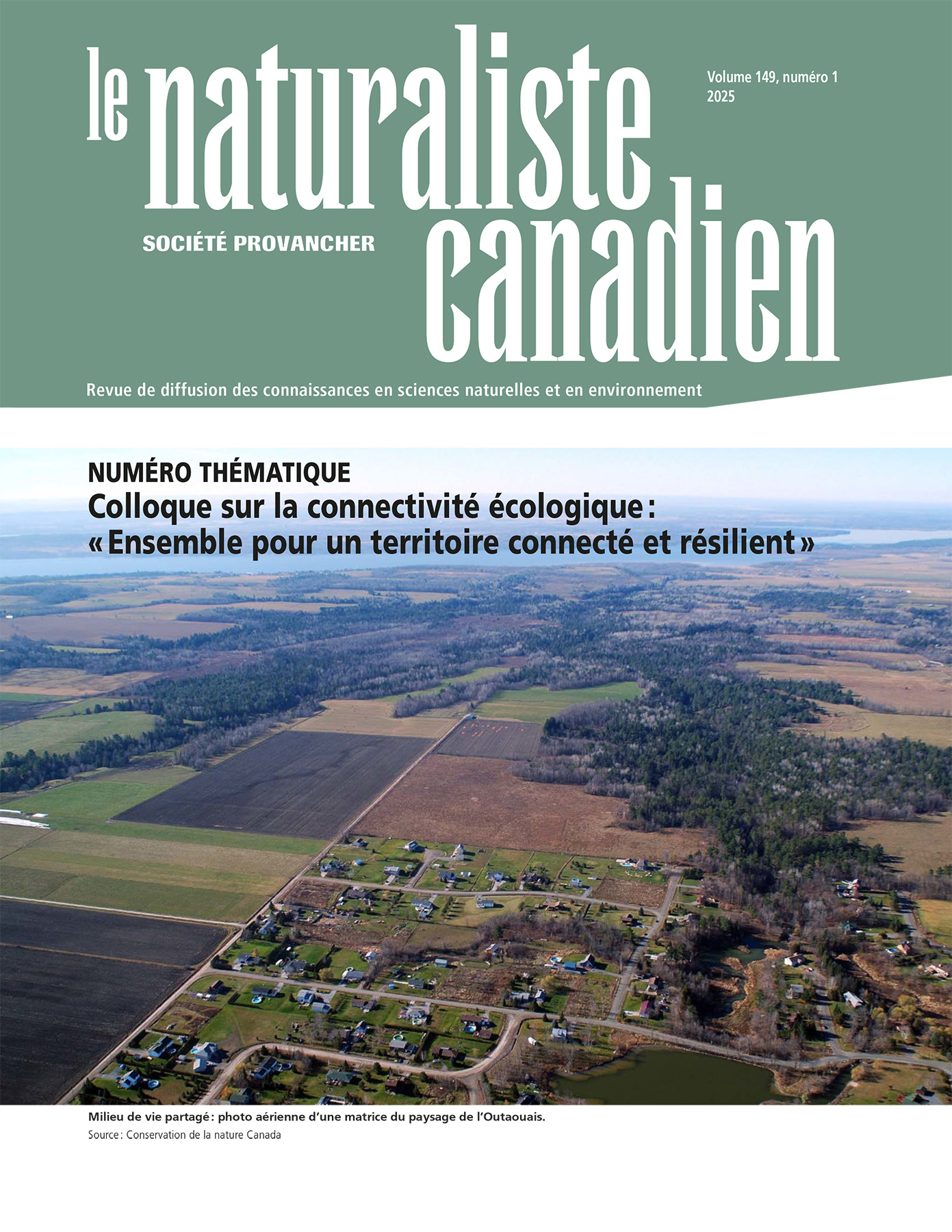Résumés
Résumé
Depuis sa construction, la route 185 reliant la ville de Rivière-du-Loup au Nouveau-Brunswick est connue pour ses enjeux de sécurité routière. Afin d’y remédier, le ministère des Transports et de la Mobilité durable (MTMD) a entrepris, au début des années 2000, le réaménagement de la route 185 en autoroute 85. L’autoroute 85 est située dans le secteur des Trois-Frontières, territoire reconnu comme étant névralgique pour la connectivité écologique au nord-est des Appalaches et situé à la jonction du Québec, du Maine et du Nouveau-Brunswick. En vue de limiter le risque de collision avec la faune et d’atténuer les répercussions du projet sur la connectivité écologique, le MTMD a entrepris de collaborer avec divers acteurs du milieu pour la conception de la phase 3 du projet. La mise en place de clôtures d’exclusion pour la grande faune jumelée à l’instauration de passages fauniques a été identifiée comme principale mesure pour assurer à la fois la sécurité des usagers et le maintien de la connectivité. Une collaboration avec l’organisme Horizon-Nature Bas-Saint-Laurent (HNBSL) a ensuite permis l’intégration de ces infrastructures et aménagements à un réseau de corridors écologiques afin de préserver la connectivité entre le ravage de cerfs de Virginie de Pohénégamook, le parc national du Lac-Témiscouata et la réserve faunique Duchénier. La concertation et les actions menées par HNBSL contribuent à préserver les milieux naturels de part et d’autre des passages fauniques. Enfin, ce texte expose l’importance des diverses collaborations au sein des différentes étapes de projet comme celui de l’autoroute 85.
Mots-clés :
- aménagements fauniques,
- concertation régionale,
- connectivité écologique,
- conservation,
- sécurité routière
Abstract
Since its construction, Route 185—running between the municipality of Rivière-du-Loup (Québec, Canada) and the New Brunswick border—has been notorious for road safety issues. To address this, the ministère des Transports et de la Mobilité Durable (MTMD) undertook to convert it to a highway in the early 2000s. Highway 85 is located in the Three Borders Region at the junction between Québec, Maine and New Brunswick, an area recognized as being crucial for ecological connectivity in the northeast Appalachians. For the design of Phase 3 of the project, the MTMD collaborated with various stakeholders to reduce the risk of wildlife collisions and mitigate the impact of the project on ecological connectivity. The installation of exclusion fencing for large animals, coupled with the establishment of wildlife crossings, was identified as the primary means of ensuring the safety of motorists and maintaining connectivity. The collaboration with the organization Horizon-Nature Bas-Saint-Laurent (HNBSL) has facilitated the integration of these infrastructures into the identified network of ecological corridors, which aim to preserve connectivity between the Pohénégamook wintering areas used by white-tailed deer, and the Témiscouata National Park and Duchénier Wildlife Reserve. The coordination and actions taken by HNBSL have contributed to the preservation of natural habitat on either side of the wildlife crossings. As a final point, this article highlights the importance of diverse collaborations throughout the different stages of a project like Highway 85.
Keywords:
- conservation,
- ecological connectivity,
- regional consultation,
- road safety,
- wildlife crossings
Parties annexes
Bibliographie
- Arkilanian, A., G. Larocque, V. Lucet, D. Schrock, C. Denépoux et A. Gonzalez, 2020. A review of ecological connectivity analysis in the Region of Resolution 40-3. Report presented to the ministère de la Faune, de la Forêt et des Parcs du Québec for the New England Governors and Eastern Canadian Premiers working group on ecological connectivity, 79 p.
- Bélanger, M., S. Ross et C. Larocque, 2016. Inventaire aérien de la grande faune : projet autoroute 85/185. Rapport technique déposé au ministère des Transports, de la Mobilité durable et de l’Électrification des transports, 5 p.
- Berteaux, D., S. de Blois, J.-F. Angers, J. Bonin, N. Casajus, M. Darveau, F. Fournier, M.M. Humphries, B. McGill, J. Larivée, T. Logan, P. Nantel, C. Périé, F. Poisson, D. Rodrigue, S. Rouleau, R. Siron, W. Thuiller et L. Vescovi, 2010. The CC-Bio project: Studying the effects of climate change on Quebec biodiversity. Diversity, 2 : 1181-1204. https://doi.org/10.3390/d2111181.
- Clevenger, A.P. et N. Waltho, 2000. Factors influencing the effectiveness of wildlife underpasses in Banff National Park, Alberta, Canada. Conservation Biology, 14 : 47-56. https://doi.org/10.1046/j.1523-1739.2000.00099-085.x.
- Consortium SNC-Lavalin/Roche, 2007. Étude d’impact sur l’environnement déposée au ministère du Développement durable, de l’Environnement et des Parcs : construction d’une autoroute entre Saint-Antonin et Saint-Louis-du-Ha ! Ha ! – route 185. Ministère des Transports, Québec, 349 p. + ann.
- Denneboom, D., A. Bar-Massada et A. Shwartz, 2021. Factors affecting usage of crossing structures by wildlife: A systematic review and meta-analysis. Science of the Total Environment, 777, 146061. https://doi.org/10.1016/j.scitotenv.2021.146061.
- Dumas, K. et J. Lamontagne, 2022. Construction de l’autoroute 85 (Phase III) : programme de compensation des pertes de milieux humides. Ministère des Transports du Québec, 66 p. + ann.
- Gagnon, M., F. Lesmerises et M.-H. St-Laurent, 2024. Temporal variations in female moose responses to roads and logging in the absence of wolves. Ecology and Evolution, 14 (2) : e10909. https://doi.org/10.1002/ece3.10909.
- Ghoddousi, A., E.K. Buchholtz, A.M. Dietsch, M.A. Williamson, S. Sharma, N. Balkenhol, T. Kuemmerle et T. Dutta, 2021. Anthropogenic resistance: Accounting for human behavior in wildlife connectivity planning. One Earth, 4 (1) : 39-48. https://doi.org/10.1016/j.oneear.2020.12.003.
- Gouvernement du Québec, 2023. Réaménagement de la route 185 en autoroute (85). Disponible en ligne à : https://www.quebec.ca/transports/projets-routiers/bas-saint-laurent/reamenagement-route-185-autoroute-85. [Visité le 2024-03-02].
- Gratton, L. et J.-F. Gagnon, 2021. Identification d’un réseau préliminaire de corridors écologiques dans l’axe Pohénégamook-Témiscouata-Duchénier. Horizon-Nature Bas-Saint-Laurent, Rimouski, 36 p.
- Gratton, L. et J. Levine, 2019. L’initiative Staying Connected : pour reconnecter la nature et les humains par-delà les frontières. Le Naturaliste canadien, 143 (1) : 12-17. https://doi.org/10.7202/1054112ar.
- [HNBSL] Horizon-Nature Bas-Saint-Laurent, 2019. Synthèse des trois ateliers de co-construction. Rimouski, 13 p. Disponible en ligne à : https://connectiviteecologique.com/sites/default/files/project_files/Rapport_Ateliers_connectivite%CC%81_BSL_web.pdf.
- Laliberté, J. et M.-H. St-Laurent, 2020. In the wrong place at the wrong time: Moose and deer movement patterns influence wildlife-vehicle collision risk. Accident Analysis & Prevention, 135. https://doi.org/10.1016/j.aap.2019.105365.
- Laliberté, J. et M.-H. St-Laurent, 2020. Validation of functional connectivity modeling: The Achilles’ heel of landscape connectivity mapping. Landscape and Urban Planning, 202. https://doi.org/10.1016/j.landurbplan.2020.103878.
- Lesbarrères, D. et L. Fahrig, 2012. Measures to reduce population fragmentation by roads: What has worked and how do we know? Trends in Ecology and Evolution, 27 : 374-380. https://doi.org/10.1016/j.tree.2012.01.015.
- Liu, C., G. Newell, M. White et A.F. Bennett, 2018. Identifying wildlife corridors for the restoration of regional habitat connectivity: A multispecies approach and comparison of resistance surfaces. PLOS ONE, 13 (11). https://doi.org/10.1371/journal.pone.0206071.
- [MTMD] Ministère des Transports et de la Mobilité durable, 2023. Autoroute 85 : un chantier qui a le vent dans les voiles. Disponible en ligne à : https://www.quebec.ca/nouvelles/actualites/details/autoroute-85-un-chantier-qui-a-le-vent-dans-les-voiles. [Visité le 2024-03-02].
- Paemelaere, E.A.D., A. Mejía, S. Quintero, M. Hallett, F. Li, A. Wilson, H. Barnabas, A. Albert, R. Li, L. Baird, G. Pereira et J. Melville, 2023. The road towards wildlife friendlier infrastructure: Mitigation planning through landscape-level priority settings and species connectivity frameworks. Environmental Impact Assessment Review, 99. https://doi.org/10.1016/j.eiar.2022.107010.
- Perkl, R., L.M. Norman, D. Mitchell, M. Feller, G. Smith et N.R. Wilson, 2018. Urban growth and landscape connectivity threats assessment at Saguaro National Park, Arizona, USA. Journal of Land Use Science, 13 (1-2) : 102-117. https://doi.org/10.1080/1747423X.2018.1455905.
- Poulin, M. et J. Fortin, 2006. Inventaire des ravages de cervidés le long de la route 185 et mesures de mitigation recommandées : projet 20-3300-0235 de Saint-Antonin à Saint-Louis-du-Ha ! Ha ! Ministère des Transports, 10 p.
- Raymond-Bourret, E. et S. Nadeau, 2018. Analyse de la connectivité faunique : territoire privé du Bas-Saint-Laurent. Agence régionale de mise en valeur des forêts privées du Bas-Saint-Laurent, Rimouski, 55 p.
- Rytwinski, T., R. van der Ree, G.M. Cunnington, L. Fahrig, C.S. Findlay, J. Houlahan, J.A.G. Jaeger, K. Soanes et E.A. van der Grift, 2015. Experimental study designs to improve the evaluation of road mitigation measures for wildlife. Journal of Environmental Management, 154 : 48-64. https://doi.org/10.1016/j.jenvman.2015.01.048.
- Van der Grift, E.A., R. van der Ree, L. Fahrig, C.S. Findlay, J. Houlahan, J.A.G. Jaeger, N. Klar, L.F. Madriñan et L. Olson, 2013. Evaluating the effectiveness of road mitigation measures. Biodiversity and Conservation, 22 : 425-448. https://doi.org/10.1007/s10531-012-0421-0.
- Woltz, H.W., J.P. Gibbs et P.K. Ducey, 2008. Road crossing structures for amphibians and reptiles: Informing design through behavioral analysis. Biological Conservation, 141 : 2745-2750. https://doi.org/10.1016/j.biocon.2008.08.010.



 10.7202/1054112ar
10.7202/1054112ar